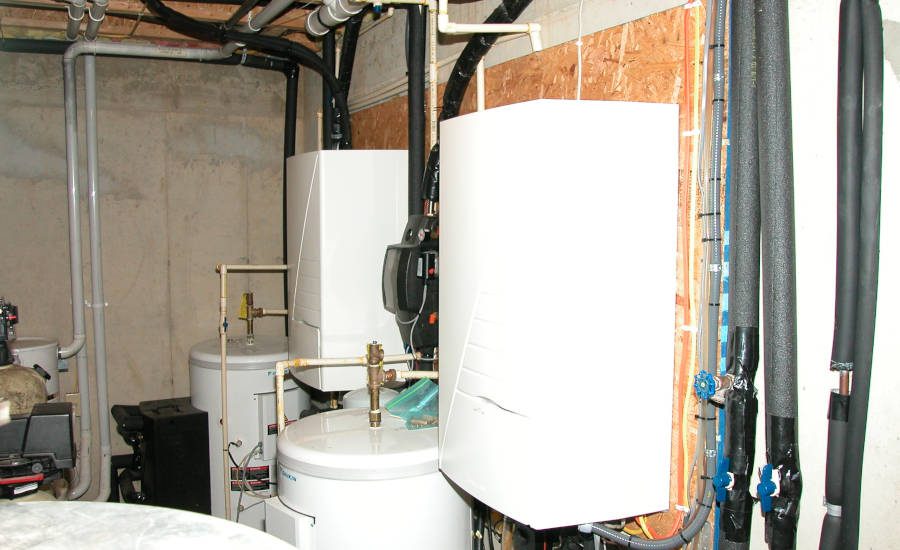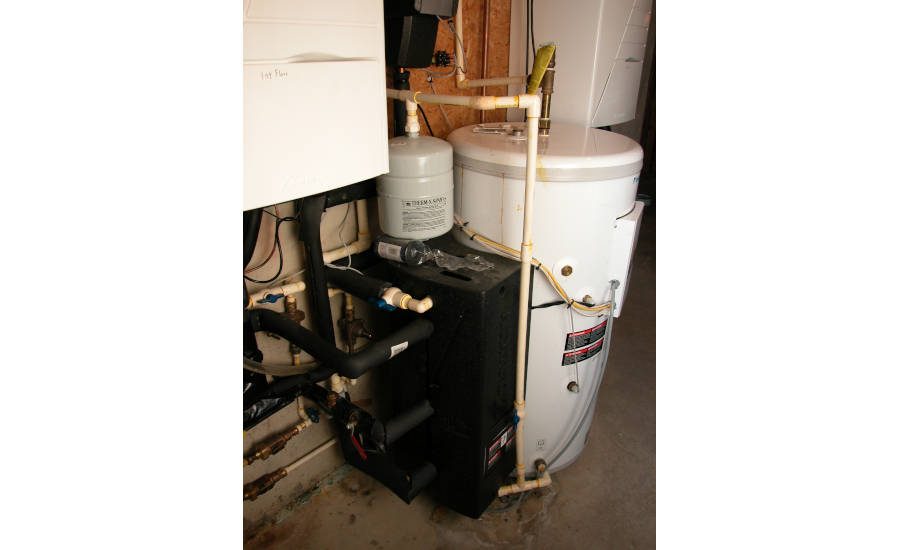Dave Yates: Heat pump mayhem
Think twice before you act.

Two 2.5-ton air-to-water heat pumps were installed with each one connected to a 50-gallon indirect water heater. Both systems incorporated solar heat exchangers and there was a vacuum tube solar array mounted on the roof to, according to the installer, provide 100% of the family’s DHW needs. Photo credit: Dave Yates









Mmanufacturer of air-to-water heat pumps called asking if I would be willing to visit a home to perform a heat loss/gain calculation where two of its heat pump systems had been installed and determine why the home was not heating and cooling to the homeowners satisfaction. The icing on the cake was the home was quite close to West Chester, Pennsylvania, where our younger son lived at the time. He belonged to a sporting clay gun club, and if I timed my visit correctly, we would be able to meet there after he finished work.
Upon arrival, the homeowner met me and laid out the heating/cooling/DHW issues:
There had been two 4-ton ducted AC systems and two 80,000-Btu/h propane-fired 92% efficiency furnaces installed when the home was built. In addition, there was a power-vented 80-gallon propane-fired water heater serving five bathrooms. All were in good working order, but a mechanical contractor had convinced him to upgrade to the inverter (variable-speed) air-to-water systems.
Two 2.5-ton air-to-water heat pumps were installed with each one connected to a 50-gallon indirect water heater. Both systems incorporated solar heat exchangers and there was a vacuum tube solar array mounted on the roof to, according to the installer, provide 100% of the family’s DHW needs.
By now you already know the problem! Me too, but first I had to go through the 5,000 square foot home to measure each room, the windows, doors and linear feet of exposed wall along with its direction North, South, East and West. The homeowner had to leave for work, but said he was going to sue the manufacturer. I asked why.
The backstory
The installing contractor had gone bankrupt, so he felt it was now the manufacturer’s responsibility. He was going to bite the hand feeding him given that the manufacturer had already generously offered to give him new properly sized equipment — to be determined from my Manual-J calculations. I suggested he had as much chance prevailing in court, as would a snowball in hell.
The final Manual-J calculation revealed the home did, in fact, require 8-tons of cooling and it was also correct that each zone needed 4-tons of cooling, so the original installer nailed that one on the head. The 80,000 Btu/h furnaces were a bit oversized, but needed the blower power for meeting the 1,600-cfm (400 cfm per ton) airflow for each system.
How in the world did the installer arrive at the conclusion two 2.5-ton (30,000 Btu/h) heat pumps could replace 8 tons of cooling and 160,000 Btu/h of heating? He claimed he always used Manual-J, but his ex-wife refused to give him the computer it was on and he turned to an internet program that came with a written disclaimer not to use it for accurate heat loss/gain calculations. D’oh!
The local supply house questioned the sizing. Was he certain he had followed correct guidelines and procedures in arriving at the sizing? He was adamant that his were the correct sizing numbers. The local supplier even offered to provide heat gain/loss calculations. No thanks. The manufacturer also questioned the sizing, but manufacturers don’t, as a general rule, provide sizing calculations. That is the ultimate responsibility of the installing contractor and/or the local wholesaler. I am correct, he affirmed adamantly, now sell me the equipment!
The horror show did not stop with just the equipment on the heating/cooling side. Teenagers live there, and as we all know, they can put a strain on any DHW system! Given that the two air-to-water heat pumps were dramatically undersized, they were devoting all energy in an attempt to meet heating/cooling demands and the programmed time-out for DHW production compounded the shortfall. Their DHW would go from lukewarm to frigid in a matter of minutes. Did I mention his children were all daughters? Imagine, if you will, you live in a home with four livid women. You think you have problems? Think again!
More problems
The solar system was another disaster. The system incorporated a Caleffi controller, so I gave Hot Rod Rohr a call (Caleffi national trainer and guru of all things solar regarding thermal systems). Turned out to be an obsolete drain-back controller — only problem — this was not set up as a drain-back system, but rather, an active system. As a result, it too was defective and did not work, so no solar boost for their DHW. Couple that with a failed attempt to “divide” flow from the solar array to the two DHW tanks using ball-valves, which cannot accurately be utilized to split the flow evenly, as has been repeatedly pounded into my head by Siggy and Robert Bean — engineers whose extraordinary patience has enabled them to teach mechanical contractors, like me, the proper methods of controlling flow in hydronic systems.
Would new properly sized air-to water heat pumps resolve the issues? In a word: No. The balance of system components presented their own mechanical mayhem horror show. PVC piping was utilized to transfer energy from the air-to-water heat pumps to two air handlers. Never mind the limited temperature boundaries for PVC in temperature/pressure relationships, the oils utilized in 410a refrigerant are not compatible with PVC and, in the event, any refrigerant oil entering the hydronic water (think: failed heat exchanger with refrigerant pressure higher than hydronic pressure) would compromise the PVC’s integrity.
Hangars and straps oh my! None were present. Instead, there were cut pieces of PVC haphazardly placed for bracing the PVC supply/return piping. We don’t need no stinking hangars or straps! (With apologies to the movie “The Treasure of the Sierra Madre.”) Ductwork was not sized correctly by Manual-D standards, but the real offense was in the attic. There I found flex duct pinched off, in excess of 60’, and looking for all the world like a bowl full of spaghetti tossed out willy-nilly with no regard for air flow. Was it any wonder the master suite (farthest distance away) was the poorest performer for comfort heating/cooling?
The aftermath
Following my report, the manufacturer did, in fact, offer free properly sized air-to-water heat pumps with air handlers that incorporated back-up electric heat to meet the difference (read: shortfall) in heating capacity. The homeowner asked if we would provide the revised installation, but balked at the cost to do a complete tear out and revise of the two systems.
A year later, the homeowners filed suit against the manufacturer. They lost the suit against the manufacturer, but prevailed in judgment against the installer. However, given the fact that the installer had long ago declared bankruptcy and that his subcontractor had too, I highly doubt he ever collected. He burned the bridge with the manufacturer for free equipment once he filed suit, so that sweet deal vanished into thin air.
Moral: Never look a gift horse in the mouth! The homeowners were super nice folks who got hornswoggled by a disreputable so-called mechanical contractor. The mechanical subcontractor he used, as it turned out, was banned by another state from doing work in that state ever again. Good grief. Let the buyers beware.
Mike and I did have a great evening shooting sporting clays and, as always, he had high score. No matter, spending a fun time with my boys attempting to dust clay birds is always quality fun time.
Looking for a reprint of this article?
From high-res PDFs to custom plaques, order your copy today!












